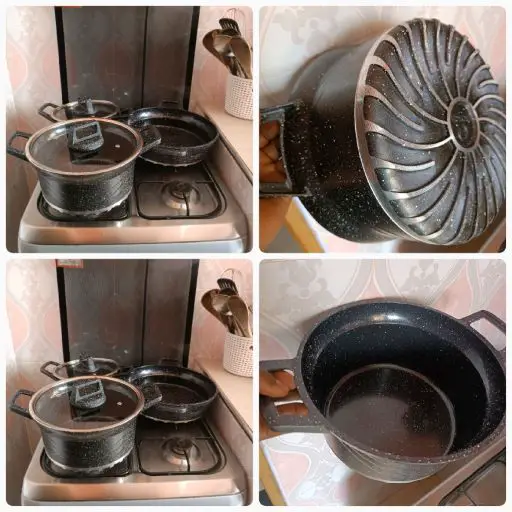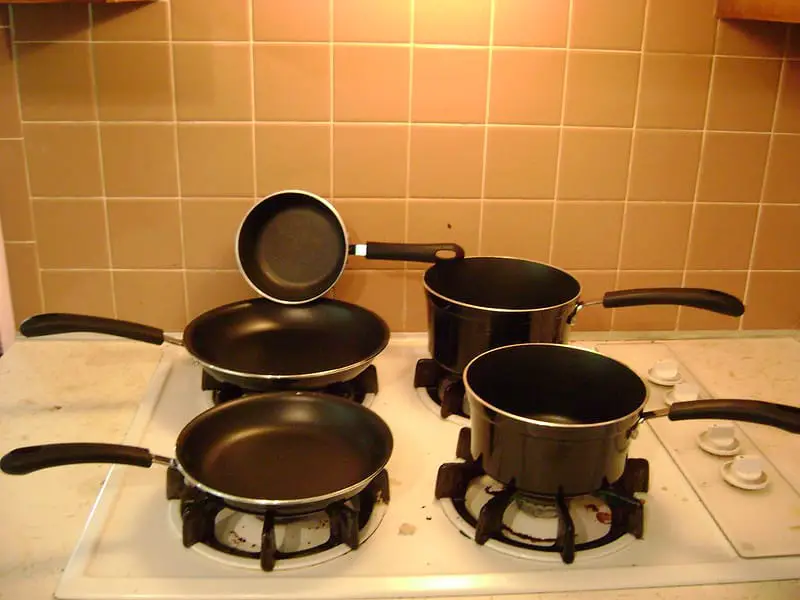A few days ago, someone asked my opinion on how safe it is to boil water in a nonstick pan.
Her question went like this:
Hi Dan,
I like how you always take a scientific approach to explain things in a way that anyone; even those who hated sciences (me included) can easily follow. You are doing a terrific job. Now to my question. I have been using nonstick cooking pots for a very long time and there are certain things I heard from my friends about the pots that I would like you to clarify. They claimed that the nonstick pans should never be used to boil water since hot water would degrade the material used to coat them and may even poison the water. Some argued it might even cause cancer! What is your take on that?
Now, this came exactly at a time my wife was also getting concerned about our nonstick cookware that had apparently lost their nonstick properties within a very short time.
Most of the pans have lost their coating, and we are not even sure that they were nonstick in the first place.
What is more worrying is the thought of whether those coating residues ended up in our food or were scrubbed off while washing the pans.
So, I dived into a rabbit hole to uncover information about nonstick cookware, and here is what I found.
What Material are Nonstick Pans Made of?
Before we go into water heating details, it is good to understand the basics about these nonstick cookware.
Most nonstick cookware is made of a metal (aluminum or cast iron) coated with a nonstick material called polytetrafluoroethylene (PTFE), or simply Teflon.
Teflon was chosen for making nonstick cookware due to its non-reactive nature when in solid form.
While Teflon in itself is relatively inert, there have been concerns about other related compounds called perfluorooctanoic acid (PFOA) and perfluorooctanesulfonate (PFOS), which are also used in making Teflon.
According to this fact sheet by the Environmental Protection Agency (EPA), several studies have shown that increased PFOA and PFOS exposure can cause:
- High cholesterol
- Decreased vaccination response
- Thyroid disorders
- Pregnancy-induced hypertension and preeclampsia
- Cancer (testicular and kidney)
- Adverse reproductive and developmental effects
The effects of Teflon on humans is a very controversial topic that has seen big multinationals fight numerous legal battles with affected individuals.
With that said, it is clear that you should be careful about how you chose your cookware and how you use them.
Can Water Be Boiled in Nonstick Pans?
Yes, it is generally safe to boil water in nonstick pans since the water will boil and evaporate at a lower temperature (212℉/ 100℃) than what it would take to break down the Teflon on standard nonstick pans (500℉/ 260℃).
One exception to this would be preheating the nonstick pan for some time and suddenly pouring water into the superhot pan.
Remember what physics says about heat and matter?
Right, matter will expand on heating and contract on cooling. But they will not do that at the same rate.
Preheating the pan will cause the metal and the Teflon coating the pan to expand rapidly.
Adding cold water to the superheated pan would cause a drastic drop in the pan’s temperature.
The shock created by sudden change in temperature will make the metal holding the Teflon coating to contract and warp.
The Teflon will be destroyed since it doesn’t contract at the same rate as the metallic part of the pan.
This makes it easy to peel off the Teflon coating with a relatively slight abrasive scrubbing when washing.
Now, my question would be; why would you want to boil water using a nonstick pan when there are so many alternatives in the kitchen?
Why not just use a kettle or water heater instead? Well, I guess there must be a solid reason behind that choice.
Anyway, let’s keep at it.
How to Safely Use a Nonstick Pan
The first line of defense regarding nonstick cookware is at the purchasing point.
You need to ensure that what you are buying is something that has passed the quality standards and safety standards.
How do you know this?
Well, you can use several metrics such as customer reviews, price range (cheap is expensive), quality assurance tags or numbers, and manufacturer’s reputation.
Sometimes, a referral from a trusted friend or family would save you the torturous process of finding legit nonstick cookware.
Since I may also be a victim of the nonstick fraud, I dedicated some time to dive into the nonstick cookware market and came up with recommendations for the best brands around.
I would also advise you to check out alternative non-PFOA nonstick cookware sets that are equally good.
Yes, they are plenty of them, as you will see later on here on my recommendation list below.
The second thing you need to do while using nonstick pans is to always use them on medium or low heat.
Most standard nonstick pans in the market are relatively safe when used under low temperatures.
Another thing you shouldn’t do with nonstick pans is scrubbing them with steel wool or tough scouring pads when washing.
If you find yourself needing to do this, just know that your nonstick pan is fake or it has lost its functionality.
I mean, what is the essence of calling it nonstick if it sticks?
For obvious reasons, avoid using metallic spoons, knives, or forks for stirring or scooping when cooking with nonstick metals.
Instead, get a set of silicone kitchen utensils or wooden utensils for that purpose.
Also, it is important to repeat what I said earlier. Avoid preheating nonstick pans whether you want to boil water or cook food.
One thing you should keep in mind is your nonstick pan also has a shelf life.
The Teflon coating will eventually come off after some time. If they start looking like mine in the photo below, it’s time to go shopping for new ones.

Alternatives to Nonstick Cookware
If all this is making you freak out already, you have the option of avoiding the Teflon-coated cookware altogether.
As for my wife and I, we decided to settle on granite cookware, and so far, we are very much satisfied with its services and efficiency.

You can also go for other cookware sets made of materials such as:


Anodized Induction Non-PFOA Nonstick Cookware


Granite Cookware (This is what we are currently using)

There are also good stainless steel cookware anodized with other metals such as silver, copper, or gold.
Always look for brands that make nonstick cookware without using PFOA or PFOS in their Teflon.
Not a single material is, however, completely devoid of safety issues or other shortcomings.
Read Also: Is it Okay to Reuse Cooking Oil After Deep Frying? How Many Times?
The thing is, you should find something that works for you and satisfies your kitchen requirements and use it according to the manufacturer’s instructions.
The toxicity from cookware is not that extreme, especially if used in low heat within recommended temperatures.
It is, however, important to always keep your guard up and minimize chances of exposing yourself and your loved ones to these harmful chemicals.



Pingback: How to Avoid Undercooking or Overcooking Rice (7 Rice Cooking Hacks)